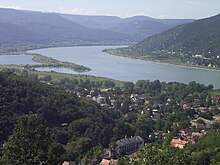Lumi i Danubit


Danubi i njohur dikur edhe me emrin Tuna [1] [2] është lumi i dytë më i gjatë në Evropë pas Vollgës. Ai e ka origjinën në Pyllin e Zi në Gjermani dhe rrjedh nga bashkimi i dy lumenjve më të vegjël, Brigach dhe Breg pranë qyteti gjerman Donaushingen. Nga kjo pikë bashkimi e më tej, lumi njihet si Danub dhe rrjedh për 2850 km duke kaluar mes Evropës Qendrore e Lindore derisa derdhet në Detin e Zi nëpërmjet Deltës së Danubit që shtrihet mes Rumanisë dhe Ukrainës. [3]
Përmbledhje
[Redakto | Redakto nëpërmjet kodit]Në histori Danubi njihet si një nga kufijtë jetëgjatë të Perandorisë Romake, ndërsa sot ai rrjedh përmes ose prek 10 shtete: Gjermaninë, Austrinë, Sllovakinë, Hungarinë, Kroacinë, Serbinë, Rumaninë, Bullgarinë, Moldavinë dhe Ukrainën me pas merr rrugen e tij drejt Detit të Zi, ku edhe derdhet. Qytetet më të mëdha në pellgun e lumit Danub janë Vjena, Budapesti, Beogradi dhe Bratislava, të cilat që të gjitha janë kryeqytetet e vendeve të tyre përkatëse. Gjashtë kryeqytete të tjera shtrihen gjithashtu në pellgun e Danubit: Bukureshti, Sofja, Zagrebi, Ljubljana. Sarajeva. Qyteti tjetër më i madh në pellgun e tij është Mynihu, kryeqyteti i Bavarisë, që qëndron në pellgun e lumin Isar, si një degë e Danubit.
Etimologjia
[Redakto | Redakto nëpërmjet kodit]Danubi (gjer.: Donau, slovak.: Dunaj, hung.: Duna, kroa.: Dunav, serb.: Дунав/Dunav, bulg.: Дунав, rum.: Dunărea, ukra.: Дунай (Dunay), lat.: Danuvius), në fund të fundit të gjithë derivojnë nga PIE *dānu, kuptohet "lumë" ose "rrymë", është lumi i dytë i Evropës sa i përket gjatësisë (pas Volgës). Për sa i përket rrugës së rrjedhjes të këtij lumi, Danubi njihet edhe si "lumi evropian pasi kalonte mes 10 shyeteve europiane (Gjermania, Austria, Sllovakia, Hungaria, Kroacia etj).
Shih edhe
[Redakto | Redakto nëpërmjet kodit]Literatura
[Redakto | Redakto nëpërmjet kodit]- Bruhàcs, János, Le Régime international du Danube en cette fin de siècle. Les hommes et l’environnement, Paris, Frison-Roche, 1998.
- Water pollution control in the Danube basin: proceedings of the International conference on water pollution control in the basin of the river Danube, held in Novi Sad, Yugoslavia, 20-23 juin 1989, Oxford, New York, Pergamon press, 1990.
- Danube delta : Genesis and biodiversity, Leyde, Backhuys, 2006.
- Blühberger, Günther, Wie die Donau nach Wien kam : die erdgeschichtliche Entwicklung der Landschaft des Donautals und der Nebenflüsse vom Ursprung der Donau bis zum Wiener Becken, Vienne, Böhlau, 1996.
- Irene Lyons Murphy, The Danube: a river basin in transition, Dordrecht, Kluwer academic publications, 1997.
- Danube delta : Geology, sedimentology, evolution: field trip, 28 September-2 October 1998, Paris, Association des sédimentologistes français, 1999.
- György Ránki, Economy and foreign policy: the struggle of the great powers for hegemony in the Danube Valley, 1919-1939, New York, Columbia university press, 1983.
- Martin Graff, Le Réveil du Danube: géopolitique vagabonde de l’Europe, Strasbourg, la Nuée bleue, 1998.
- Claudio Magris, Danube, Gallimard : 1988, ISBN 2070780023
- Stefanescu, Constantin-Mircea, Nouvelles contributions à l’étude de la formation et de l’évolution du delta du Danube : essai d’interprétation de la morphogenèse du delta à l’époque historique à partir de la toponymie, de l’histoire et des cartes anciennes, Paris, Bibliothèque nationale, 1981.
- Frucht, Richard C., Dunarea noastra Romania, the great powers and the Danube question, 1914-1921, New York : Columbia university press, 1982.
- Charles R. Bowlus, Franks, Moravians and Magyars: the struggle for the Middle Danube, 788-907, Philadelphie: University of Pennsylvania press, 1995.
- Dise, Robert L., Cultural change and imperial administration: the middle Danube provinces of the Roman Empire, New York, P. Lang, 1991.
- Rapport d’information sur l’exemple que constitue pour la liaison Rhin-Rhône et les voies navigables françaises, l’achèvement de l’axe fluvial à gabarit européen Rhin-Main-Danube, Sénat, Troisième session extraordinaire de 1993-1994 ; fait au nom de la Commission des affaires économiques et du plan, Paris, Sénat, 1994.
- Ørsted, Peter, Roman imperial economy and Romanization: a study in Roman imperial administration and the public lease system in the Danubian provinces from the first to the third century A.D., Copenhague, Museum Tusculanum press, 1985.
- Robert, Éric, L’Affaire relative au projet Gabcikovo-Nagymaros (Hongrie/Slovaquie). Un nouveau conflit en matière d’environnement devant la Cour internationale de justice ? / Éric Robert. Studia diplomatica, volume 47 (1994-5), faqja17-52.
- McIntyre, Owen, Case concering the Gabcikovo-Nagymaros project (Hungary/Slovakia) : International Court of Justice, La Haye, 25 septembre 1997. Journal of Environmental Law, volume 10 (1998-1), faqja79-91.
- Maljean-Dubois, Sandrine, L’arrêt rendu par la Cour internationale de Justice le 25 septembre 1997 en l’affaire relative au projet Gabcikovo-Nagymaros (Hongrie/Slovaquie). Annuaire français de droit international, volume 43/1997 (1998), faqja286-332.
- Kovács, Péter, Quelques considérations sur l’appréciation et l’interprétation de l’arrêt de la Cour internationale de justice, rendu dans l’affaire Gabcikovo-Nagymaros. German Yearbook of International Law, volume 41 (1999), faqja252-266.
- Romsics, Ignác et Nóra Arató, Geopolitics in the Danube region: Hungarian reconciliation efforts, 1848-1998, Central European University Press, 1999.
Referime
[Redakto | Redakto nëpërmjet kodit]- ^ Kozma Vasili; Arsen Mustaqi, red. (1981), Lirika popullore [Folk lyrics], Folklor Shqiptar, vëll. 4, Tirana: Akademia e Shkencave e Shqipërisë, Instituti i Kulturës Popullore, Sektori i Prozes dhe Poezise, fq. 624,
Tunë-a lumi i Danubit
- ^ Anës lumenjve - Larg prej vatrës dhe prej punës, Anës Rinit, anës Tunës. Çakërdisur, batërdisur, Përpëlitur dhe zalisur, ... (Fan S. Noli)
- ^ Šašel Kos, Marjeta (2009). "Reka kot božanstvo — Sava v antiki" [River as a Deity – The Sava in Antiquity]. përmbledhur nga Barachini, Jožef (red.). Ukročena lepotica: Sava in njene zgodbe [The Tamed Beauty: The Sava and Its Stories] (PDF) (në sllovenisht dhe anglisht). Sevnica: Javni zavod za kulturo, šport, turizem in mladinske dejavnosti. fq. 42–50. ISBN 978-961-92735-0-0. Arkivuar nga origjinali (PDF) më 4 mars 2016.
